Published
on 7
Jan 2018
|
All rights reserved.
|
|
|
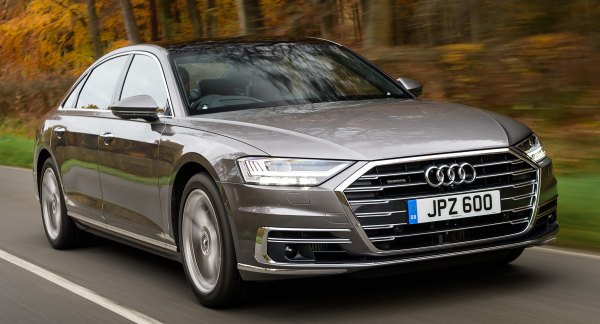
|
|
Claimed
to be the world's most advanced car, can it beat Mercedes S-class?
|
|
Audi’s
top luxury line started in 1988 with V8 (yes, the car was really called
“V8”), evolved through 3 generations of A8 until today. The A8 was
originally famous for pioneering aluminum spaceframe chassis for mass
production. However, that did not earn it more sales. Throughout the
years, the A8 failed to rock Mercedes S-class from the domination of
F-segment limousines. In fact, it also failed to match BMW 7-Series and
usually Lexus LS as well on the global market. What went wrong was hard
to explain. The A8 used to be known for avant-garde styling and
technology, but somehow not many people saw it as the symbol of luxury.
Perhaps the customers in this segment are generally older, more
conservative and usually sit at the rear, Audi started shifting the
priorities since last generation. In the new 4th generation car, you
can see it evolves further to that direction.
The styling of the new car is rather conservative, more so than any of
its main rivals. Yes, its hexagonal grille gets wider and more angular,
but you won’t say it radical, just like you won’t describe the ever
larger grille of Rolls-Royce a progress. The combination of a flat
bonnet and an upright nose makes the front look bulky, more like the Q7
SUV than a limousine – yes, it does ride on the Q7’s MLB-Evo platform,
but that is not an excuse for the bulky look. The general profile of
the car is rather dull and characterless, lacking the sculpted
aesthetic of Mercedes S-class. Audi said the 2014 Prologue luxury coupe
concept was used as its inspiration, but sadly I found none of its
aesthetic is carried over. Don't get me wrong, this is by no means an
ugly car, but it just fails to stand out or move the design trend
forward.
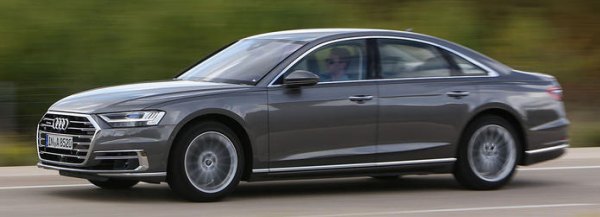
|
|
The
nose looks bulky like Q7, with which it shares platform.
|
|
The new car is marginally
larger than its predecessor. In standard form it is 5172mm long
(+37mm), 1945mm wide (-4mm), 1473mm tall (+13mm), while its 2998mm
wheelbase grows by barely 6mm. Long wheelbase model, or A8 L, adds
130mm to both the car's length and wheelbase.
In terms of technology, this car is claimed to eclipse Mercedes S-class
and BMW 7-Series to be the world's most advanced mass production car.
Its long list of technology starts from a multi-material spaceframe
chassis that consists of aluminum, magnesium and carbon-fiber
reinforced plastics (see illustration below). The majority of the
body-and-white, or 58% by weight, is still aluminum in various forms,
i.e. stamped, extrusion and casting, but the places subjected to the
most severe side impact, i.e. side rails, A and B-pillars, are now made
of ultra-high strength steel, which is stronger than aluminum in
equivalent size. Meanwhile, the wall separating between passenger cell
and boot is made of CFRP, while the front suspension tower brace is
made of magnesium. The whole structure is 24 percent stronger
torsionally. On the downside, its weight is increased by 51kg,
something Audi thought worthwhile as its priority is adding refinement.
You
can't help feeling disappointed that the new A8 is now 200 kg heavier
than BMW 7-Series. Ironically, now the BMW employs even more exotic
materials, especially carbon-fiber.
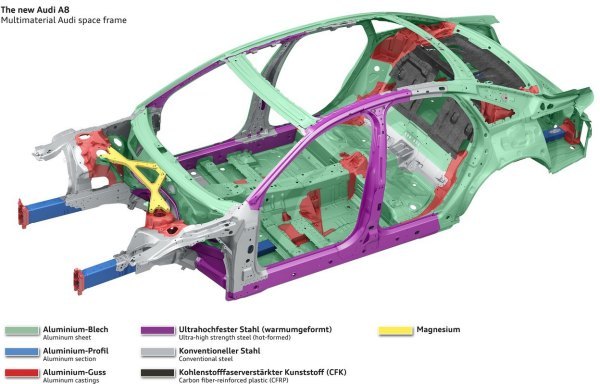
|
|
Multi-material
chassis replaces ASF, gains rigidity but also weight.
|
|
As before, all
suspensions are aluminum 5-link setup and mounted on subframe. They are
served with adaptive air springs and dampers, but the headline has to
be the optional “AI active suspension”. In that case, each corner is
served with an electric motor, which can apply up to 811 lbft of torque
to the suspension through a coupling rod, raising or lowering the
suspension rapidly to deal with bumps or resist body roll. Moreover, in
case
a side collision is anticipated by the intelligent impact detection
system,
it can jack up the suspension of that side so that the strongest
section of the body (i.e. the sill) is positioned optimally against
the impact. The electric motor at each corner is supplied by the car's
48V electrical system, which is pioneered by SQ7.
The active suspension needs better road-reading. This is made possible
by using a new laser scanner (mounted at the front bumper) in
conjunction with long-range radar and cameras. These hardware also
allow the A8 to be the world's first production car capable of Level 3
autonomous driving under some conditions without needing the driver to
keep monitoring. In traffic jam, if the driver activates the autonomous
driving function, the car will follow the traffic, applying
accelerator, brake and steering automatically. However, it is not yet
developed to be fool-proof at higher speeds, so above 60km/h (37mph) it
will give control back to the driver. If he fails to react, the car
will brake to stop.
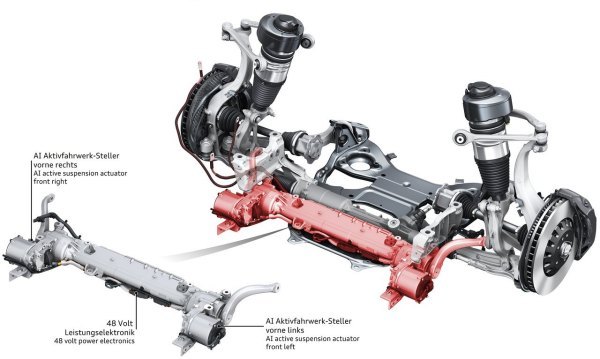
|
|
AI
active suspension uses electric motor to raise and lower each
suspension.
|
|
The 48V electrical system
is supplied by a Li-ion battery mounted under the boot. It is charged
by a new, more powerful starter-alternator which can recover as much as
13kW from braking. Predictably, this allows the A8 to feature standard
mild-hybrid power. You might remember I talked about ZF's
hybrid 8-speed transmission not long ago. It contains a disc-shape
electric motor inside the transmission casing. With this transmission,
the A8 can utilize electric power to assist propulsion in coasting
mode. This allows the car to coast at up to 100mph with the engine shut
down for up to 40 seconds. The electric motor may also assist
acceleration. The mild-hybrid tech is claimed to reduce fuel
consumption by 0.7 liter/100km, or about 8 percent for a base petrol A8.
Comparatively, the engine range is more predictable. It consists of 3
petrol and 2 diesel engines:
- 3.0 TDI V6, 286hp;
- 3.0 TFSI V6 with single turbo and Miller-cycle
capability, 340hp;
- 4.0 TDI V8 with twin-turbo and e-booster, 435hp and
664lbft;
- 4.0 TFSI V8 with cylinder deactivation, 460hp;
- 6.0 TFSI W12 with cylinder deactivation, 585hp.
The last one is e-tron, a PHEV combining the 3.0TFSI engine, an
electric motor and a 14.1kWh lithium battery for a combined output of
449hp and electric range of 50km. Again, the electric motor is part of
the ZF Hybrid
transmission, but it opts for the largest, 122hp, motor.
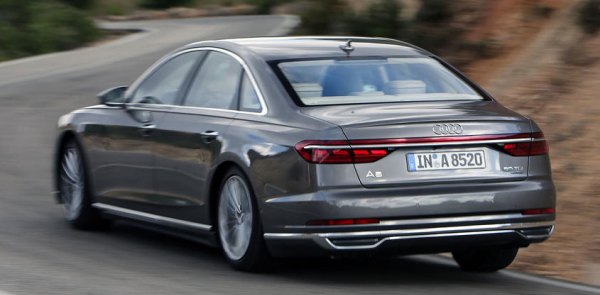
|
|
The
A8 feels big and heavy only when you hustle it on narrower, twistier
roads, where understeer takes control.
|
|
As expected, Quattro system is standard across the range. It uses crown-gear
center differential to split torque 40:60 front to
rear under normal driving conditions. Active rear differential and
active rear-wheel steering are optional. Besides, the A8 features
high-tech headlights with LED matrix beams and laser spot, OLED
taillights, remote self-parking technology and active noise
cancellation. To call it the world’s most advanced car is not
overstated.
In the Cabin
The cabin of A8 is a stark contrast to that of Mercedes S-class. While
the S-class is curvy and classical, the A8 is cool and avant-garde.
Both employ top-notch materials, but the leather in Audi is harder,
the seats are firmer and the whole ambience is not quite as inviting.
IT addicts might prefer the Audi though, because it has replaced the
MMI control with a haptic touchscreen on the transmission tunnel, whose
operation is certainly easier once you have learned it. There is
another touchscreen on the center console, and the instrument pod is
filled with “Audi Virtual Cockpit” high-definition TFT screen.
Moreover, the touchscreen are covered with glass which runs seamlessly
across the dashboard and transmission tunnel. Fit and finish is typical
Audi grade, which means second to none.
Expectedly, the cabin is spacious. Even in standard wheelbase form the
rear seat has generous legroom and headroom. Long-wheelbase passengers
get reclining seats, massaging and warming footrest and individual
infotainment systems.
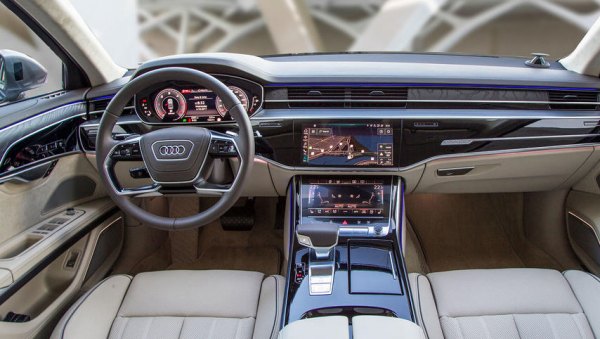 |
|
While
the S-class is curvy and classical, the A8 is cool and avant-garde.
|
|
On the Road
As a luxury limousine, the A8 does not disappoint on the road. Its air
suspension delivers smooth and quiet ride on most roads. Only on the
bumpiest roads you will find it does not quite match a Mercedes S-class
for ride suppleness and tire noise suppression. At this moment, the AI
active suspension is not available yet, but prototype tests found it
might not be as superior as imagined, especially over high-frequency
sharp bumps where it is not capable to react quickly enough. That said,
the standard air suspension is already good enough for most customers.
The cabin is also very well insulated from the outside world, except a
bit more wind noise than desired from the mirrors at very high speed.
The engine is smooth and hushed in normal driving, including the base
six-cylinder diesel.
The handling is no match for Porsche Panamera or Jaguar XJ, of course,
but for a non-performance limousine it is good. Body roll is tightly
controlled by the air suspension and adaptive dampers in Dynamic mode.
Steering is accurate and well weighted, if numb. Grip and traction is
abundant. 4-wheel steering shrinks it around town and stabilizes it at
speed. The A8 feels big and heavy only when you hustle it on narrower,
twistier roads, where understeer takes control.
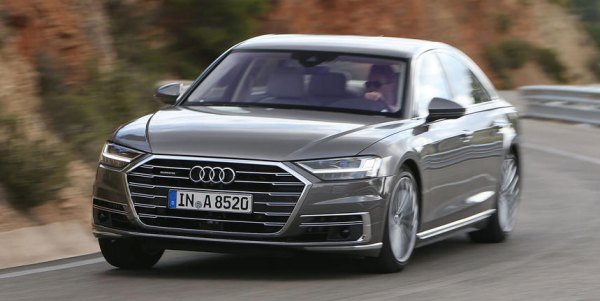
|
|
For
a non-performance limousine, its handling is good.
|
|
Although the new A8 gains
around 100 kg, all its engines get more powerful and torquey, so
performance is still improved a little. Even the base 3.0TDI offers
respectable performance, capable of 0-60 mph in 5.6 seconds, although
it sounds coarser when pressed. The petrol 3.0TFSI is faster still at
5.3 seconds, but the diesel feels more effortless at low speed due to
its superior torque. It does run quieter and rev more cleanly.
Meanwhile, the 4-liter petrol V8 is a lot stronger, sounds better yet
runs smoother still, but I suppose most customers, especially Chinese,
will be settled with the more economical petrol V6. The diesel V8 is a
marvelous motor, as on SQ7, but it is probably over the top,
unnecessarily complicated and costly to build. The range-topping W12 is
not available yet, but its sibling works fine on Bentley Continental
GT. Just pay attention to its weight and thirst.
The new A8 is an all-round luxury limousine. It does the luxury thing
remarkably well and feels very well built. Dynamically, it is also a
noticeable improvement from the past and should satisfy most customer’s
expectation. Unlike the 7-Series or XJ, it has no particular weakness,
save the conservative styling perhaps. Nevertheless, Mercedes S-class
just feels a tad better in key aspects – the styling is more tasteful,
the interior more special, the ride more comfortable and the refinement
level even higher. While Audi is closer than ever, it still fails to
rock the King from its seat.
|
Verdict:     |
Published
on 25
Mar 2020
|
All rights reserved.
|
|
Audi S8
|
|
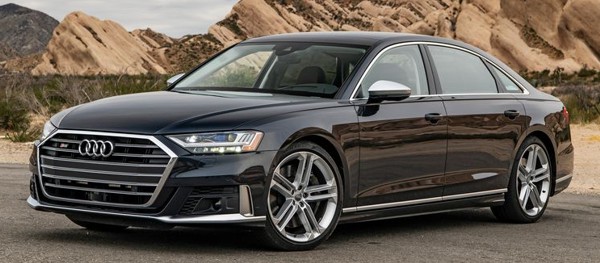
|
|
This
performance limousine is more limousine than performance...
|
|
Frankly, F-segment
performance limousine is superfluous. A couple of decades ago, most
luxury limousines were rather slow. For example, a 1998 Mercedes S500
took over 6 seconds to go from 0-60 mph. There was real demand and
market space for a high-performance derivative – the S55 AMG satisfied
that demand by improving 0-60 to 4.6 seconds. Today, an S560 4matic is
already good for 4.4 seconds, how many buyers need higher performance?
In the end, the demand comes down to perception and desirability more
than true needs. Another reason is, F-segment cars have elevated from
driver’s cars to chauffeur’s cars. Even if their owners are willing to
take the helm by themselves, these limousines become so large, heavy
and well-insulated that they could no longer bring any excitement
beyond seeing the outside scenery disappearing quickly. Moreover, most
buyers own also other performance cars, such as a Porsche 911 or a
Ferrari. There is really no need to chase for a luxury car combining
with supercar performance.
The Audi S8 faces the same problem. 2 generations ago, its existence
could be still justified by using a unique V10 engine, which shortened
0-60 acceleration from 6.5 to 5.0 seconds, accompanied with a unique
sound. In the last generation, it employed just a higher tuned version
of the 4.0TFSI V8 that powered the regular A8, reducing the gap to just
0.3 second. Attraction was reduced proportionally. Today, the new S8
has widened the gap a little bit, but taking 3.7 seconds to go from
0-60 is no longer an exclusive experience. In fact, you can buy a hot
hatch nearly as quick these days (i.e. AMG A45 S). More worrying, the
new S8 tips the scale at 2230 kg without occupants, a massive 255 kg up
from the old car. This performance limousine is more limousine than
performance.
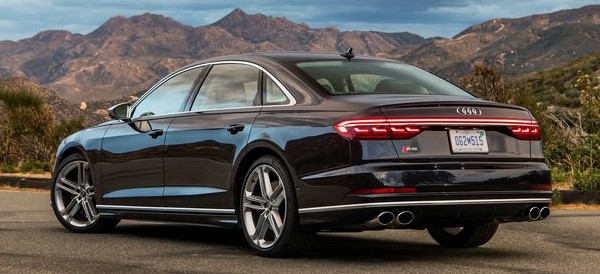
|
|
Active
suspension and rear-wheel steering give it remarkable composure and
agility...
|
|
The S8 again employs a higher boosted version of the 4.0TFSI V8. Power
and torque are lifted to 571 hp and 590 lbft, respectively, but it is
not even the best this motor can do – the RS6 is good for 600 hp. 48V
starter-generator of the mid-hybrid system helps it to improve
efficiency a little, but otherwise there is nothing new to this motor.
Ditto the impeccable ZF 8-speed automatic and the Quattro system.
Anything can dip under 4 seconds in 0-60 sprint is fast, but in the S8
you won’t feel so fast as its cabin is insulated from the outside world
so well and the ride is so smooth. There is no much sensation to speak
of. In a Mercedes S63, you can still appreciate the AMG’s sonorous
exhaust howl. In the Audi, it is no more than a distant burble.
More appreciable is the handling and ride combination. Audi’s AI active
suspension is now rebranded as “Predictive Active Suspension”. When the
A8 was launched a couple of years ago, it was demonstrated to the world
in prototype form. Since then few motoring journalists had chances to
try it. The active suspension is proved a great companion to the S8. It
employs cameras, radars and laser scanners to scan the road ahead, then
uses electric actuators to lift or compress each suspension to deal
with bumps. It works, giving the S8 remarkable composure over
undulations, although sharper intrusions or speed bumps reveal its
limitation. Meanwhile, the standard rear-wheel steering and active
differential give the car amazing agility. It handles like a smaller
car. The steering is accurate and understeer is well tamed. Switch to
Comfort mode, the air suspension softens, the engine runs inaudibly and
the S8 turns back to a luxury limousine.
However, the regular A8 can be opted for these equipment, too. The
advantage of S8 lies solely on its extra power. It does not look much
different from lesser A8s, too. Save unique quad-tailpipes and a
slightly different front bumper, there is not much to distinguish them.
This means it remains to please conservative taste. It might be a good
Q-car, but there are not sufficient reasons to justify its existence.
|
Verdict:    |
|